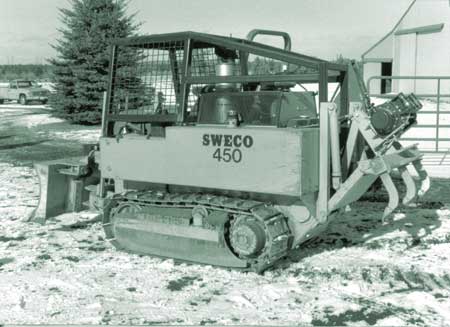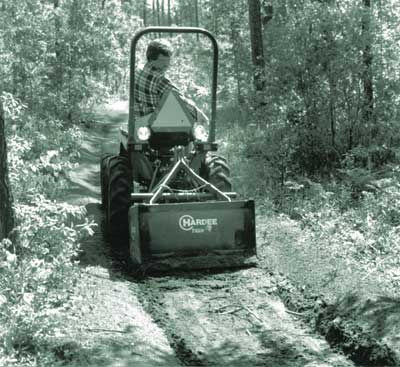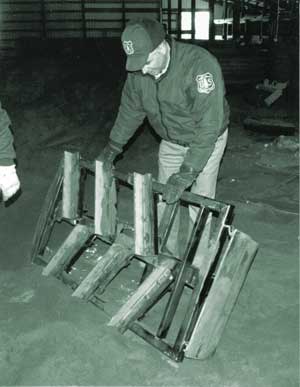Heavy–Duty Trail Grading Equipment and Accessories
For many trail jobs, an ATV is not powerful enough. Larger equipment is needed. A number of small utility tractors, crawler tractors, and excavators (Figure 21 and Figure 22) have enough power to handle these larger jobs.

Figure 21—The SWECO 450
light crawler dozer
has been upgraded to the 480 model.

Figure 22—Utility tractors
are very
versatile and useful for heavy–duty trail work.
The almost unlimited number of accessories for these machines goes beyond the scope of this report. They include dozer blades, rototillers, rippers, and backhoes. However, a few accessories relate specifically to trail grading.
TrailPlaneThe most elaborate trail grader brought to our attention was one developed by Mel Lill for the Cycle Conservation Club of Michigan. A wider version based on modifications of this design was fabricated by the Michigan Department of Natural Resources' Forest Fire Experiment Station (Figure 23). The TrailPlane consists of a hydraulically operated box scraper followed by a 350–pound (158–kg) roller. The roller pivots behind the box scraper, steered hydraulically to follow in the tracks of the tractor around tight turns.

Figure 23—Mel Lill's TrailPlane,
shown as modified by the Michigan Department of
Natural Resources (photo by Michigan DNR).
Michigan has an extensive system of OHV trails. Most of the trails originated as motorcycle paths specified to be 24 inches (60 cm) wide on the ground and 40 inches (102 cm) clear at handlebar height. Michigan's soil is generally light and sandy. Under heavy use, OHV trails tend to form whoop–de–doos. With the increasing numbers of ATV's, many trails have been widened to 50 inches (127 cm) clear from the ground up. To a large extent, they retain the tight turns and steep slopes of the original paths.
The Cycle Conservation Club of Michigan is a user group with great involvement in developing and maintaining OHV trails. When funds became available from OHV license fees, club chapters under contract with the Michigan Department of Natural Resources developed and marked many more loops and connecting trails.
By 1989, it became apparent that the whoop–de–doos were a threat to the future of the trail system. Club members began developing trail–grading equipment suited to Michigan. To meet the specifications for motorcycle trails, they chose a compact diesel four–wheel–drive tractor under 40 inches (102 cm) wide and built a grader box and roller that were just 24 inches (61 cm) wide. The grader box is carried between a centerpoint hitch on the lower links of the tractor and a ballast–filled roller in the back. The box has a cutter blade in front as well as a scraper blade in back. The box is suspended like a landplane between the back wheels of the tractor and the rear roller. When the tractor and the roller drop down into hollows in the trail, the grader box cuts into the hump between them. The roller is also steered by a master cylinder–slave cylinder system so that it follows in the tracks of the tractor around tight turns. The complete machine is called a TrailPlane.
In addition to the original 24–inch (61–cm) TrailPlane, the club has developed a 39–inch (99–cm) unit pulled by a 43–inch (109–cm)–wide tractor for motorcycle trails that have begun to be used by small ATV's. For trails that have been officially widened for 50–inch (127–cm) ATV's, the Michigan Department of Natural Resources Forest Fire Experiment Station built a 46–inch (117–cm)–wide unit.
The Michigan DNR's version (Figure 23) is towed by a four–wheel–drive Ford Model 1715 tractor. This tractor was selected because it provided the most power for tractors that could be reduced to a width of about 50 inches (127 m) wide. A front–mounted electric winch and limb risers were added to the tractor.
The DNR's system consists of a box grader, followed by a roller. The box grader is coupled to the tractor's three–point hitch with a torsion dampener arm. Adjustable root cutters are located on the box's front corners. An operator–controlled hydraulic cylinder above the roller changes the box grader attack angle. Depth of cut is controlled by setting the hitch height. The minimum inside turning radius of the system is 48 inches (122 cm). The system's path width is 68¼ inches (2 m) for that turning radius.
On the trail, each TrailPlane requires a helper on an OHV (usually a motorcycle) to scout ahead for blowdowns and other obstacles. The helper can trim brush, replace signs, and assist the operator if the tractor gets stuck. Speeds average about 4 miles per hour (6.4 kilometers per hour).
Trail grading is always done in round trips, giving the trail at least two passes as the TrailPlane returns to the unloading point. The worst whoop–de–doos cannot be completely cut down in two passes. In such cases, the unit is turned around in the woods to give them extra passes. The best grooming is often done late in the fall, allowing the graded trailbed to consolidate over the winter.
The TrailPlane does not disturb the trailbed below the average grade, so it minimizes areas of deep loose sand, found frequently on Michigan's snowmobile trails that are leveled with road–grading equipment.
CultipackerThe cultipacker (Figure 24), used in agricultural applications, was too heavy to be pulled by an ATV. It can be used with a tractor such as the SWECO 480. It can push small rocks down into the trail tread, and breaks up highly fractured or soft rocks. It provides very little compaction.

Figure 24—The cultipacker
does not rate as a "must have" trail implement.
Landscaping box scrapers (Figure 25) generally are too heavy to be pulled by an ATV, but can be pulled with a small tractor. With a skilled operator and several passes up and down the trail, the box scraper does a good job of leveling whoop–de–doos. Cutting the mounds and filling the depressions does not happen automatically as the machine goes down the trail. Constant monitoring and adjustments by the operator and frequent back–and–forth motions are needed.

Figure 25—This box scraper,
cut down to a width of 3 feet
(0.9 m), does a good job of removing whoop–de–doos,
but requires a skilled operator and a tractor.
A rock rake (Figure 26) cut down to a width of 3 feet (0.9 m) and mounted on a utility tractor worked well on the Wambaw Cycle Trail.

Figure 26—A 3–foot
(0.9–m) rock rake proved to
be another good tractor accessory.
A John Deere 855 four–wheel–drive tractor pulls this heavy–duty drag (Figure 27) on straighter trails in open country on the East Fort Rock OHV area. Its weight and aggressive cutting action were too much for an ATV to handle, but it provides fast and excellent grooming when pulled behind the tractor. A tine harrow can be attached behind the heavy–duty drag for a smooth finished trail.

Figure 27—Dick Dufourd
inspect "Big Bertha." It's aggressive cutting
action and weight are too much for an ATV to handle, but it works great
in sandy soil when towed by a tractor.
A compacted, groomed trail will last two to three times longer than one that has not been compacted. Dick Dufourd has found that a tandem drum vibratory roller (Figure 28) works best for compaction. The process is slow, and there must be adequate soil moisture for it to work well.

Figure 28—This Bomag walk–behind
vibratory
roller provides excellent compaction but is slow.

